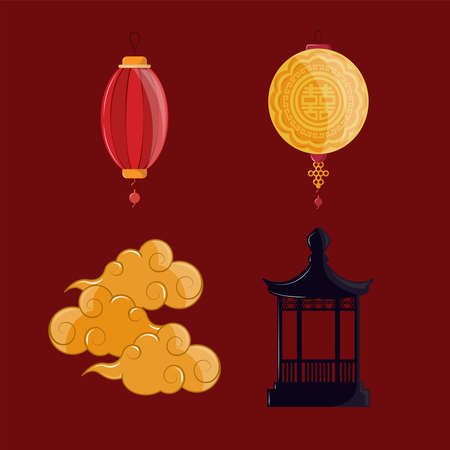Introduction: The Crossroads of Feng Shui and British Culture
Feng Shui, an ancient practice deeply rooted in Eastern philosophy, has travelled far beyond its Chinese origins to gain a foothold in the West. In recent decades, British society has shown a growing curiosity about this enigmatic system of harmonising spaces, yet the journey from East to West is anything but straightforward. While the principles of Feng Shui are based on centuries-old understandings of energy flow and environmental balance, their translation into British homes and workplaces often reveals a fascinating clash of worldviews. This article explores how Feng Shui symbols—rich with cultural significance in their homeland—can become ambiguous or even misunderstood as they intersect with British expectations, aesthetics, and sensibilities. By examining these cross-cultural encounters, we gain insight not only into the adaptability of Feng Shui but also into the unique character of British interpretations of space, symbolism, and wellbeing.
2. Key Feng Shui Symbols: Origins and Meanings
Feng Shui, a practice deeply rooted in Chinese philosophy and cosmology, employs a range of symbolic objects to influence energy flow and enhance harmony within spaces. While these symbols are now found in homes and offices across the globe—including the UK—their original meanings are often lost or altered through cultural translation. Below is an overview of some of the most recognised Feng Shui symbols, their traditional Eastern significance, and how they might be perceived differently in Western contexts.
| Symbol | Traditional Meaning (East) | Typical Use |
|---|---|---|
| Bagua Mirror | A protective symbol used to deflect negative energies or “sha chi.” Often hung outside above entrances. | Placed facing outwards from doors or windows to protect the home from harmful external influences. |
| Dragon | Represents power, strength, and good fortune. The dragon is one of the four celestial animals in Feng Shui. | Displayed in living rooms or offices to attract prosperity and success. |
| Lucky Bamboo | Symbolises resilience, flexibility, and luck. The number of stalks conveys different blessings (e.g., three for happiness, five for wealth). | Commonly placed in homes or workplaces as a living charm for positive energy and growth. |
These symbols carry nuanced meanings shaped by centuries of Chinese tradition. For instance, the Bagua mirror is not merely decorative—it is believed to interact with invisible forces around a building. Similarly, the dragon is much more than a mythical creature; it’s seen as a potent bringer of yang energy. Lucky bamboo arrangements are carefully selected based on numerology and spatial arrangement principles. When these symbols are adopted in Western settings like the UK, their original purpose may be overlooked or simplified into general notions of “good luck” or “protection,” sometimes missing their deeper philosophical context.

3. Lost in Translation: Common Misunderstandings
When Feng Shui first arrived on British shores, its core symbols—such as the dragon, the Bagua mirror, or the placement of water features—were often stripped of their original cultural context. Instead of being seen as part of a holistic worldview deeply rooted in Chinese philosophy, these items became fashionable accessories or quirky ornaments. Take, for example, the ubiquitous “lucky bamboo” found in countless UK offices and homes. In traditional Feng Shui, bamboo symbolises resilience and flexibility, but also depends heavily on its number of stalks and placement. In Britain, however, it is commonly treated as a generic token of good fortune—its arrangement and care overlooked or misunderstood.
This simplification extends to other symbols as well. The use of mirrors is a case in point. While mirrors are strategically placed in Chinese homes to reflect positive energy or deflect negative forces (sha chi), British interpretations often focus solely on aesthetics or the illusion of space, missing their intended metaphysical purpose. Similarly, the colour red—a potent symbol for protection and prosperity in Chinese culture—might appear in British interiors merely as a design choice, with little awareness of its deeper significance.
The commercialisation of Feng Shui has further muddied the waters. Many British retailers sell so-called “Feng Shui kits” containing coins, crystals, or figurines like laughing Buddhas without guidance on their true meaning or correct usage. This commodification reduces centuries-old wisdom to mere consumer goods, diluting the practice’s authenticity and effectiveness.
Moreover, popular media coverage in the UK tends to reinforce these misunderstandings by presenting Feng Shui as a quick fix for luck or wealth. For instance, advice columns may suggest placing a water feature near your front door to attract money without considering individual circumstances or the broader environmental context—a fundamental aspect in genuine Feng Shui practice.
These examples show how cultural translation gaps can lead to superficial applications of Feng Shui in Britain. Without proper understanding or respect for its origins, both the symbolism and potential benefits of this ancient practice risk being lost entirely amid Western reinterpretations.
4. Examples on British Soil: Repurposed Symbols
Across the UK, Feng Shui symbols have found their way into homes, gardens, and public spaces—often in forms that would surprise traditional practitioners. In many cases, these objects are adopted for their perceived aesthetic or mystical qualities, rather than their nuanced cultural meanings. The following table showcases several real-life scenarios where classic Feng Shui elements have been ‘repurposed’ or reinterpreted within a British context:
| Location | Symbol Used | Original Meaning (Chinese Context) | British Interpretation/Usage |
|---|---|---|---|
| Urban Flat in Manchester | Bamboo Plant | Symbol of resilience and upward growth; attracts luck when placed correctly. | Used mainly as a stylish houseplant; sometimes called “lucky bamboo” but often placed without regard to orientation or number of stalks. |
| Cotswolds Country Garden | Koi Pond | Koi represent perseverance, abundance, and harmony with water features carefully oriented. | Pond built for tranquillity; koi added for colour and novelty, not always considering water flow or energy lines. |
| London Office Lobby | Laughing Buddha Statue | Invites prosperity and joy when placed facing the main entrance. | Treated as quirky décor; sometimes tucked away on a shelf, with little awareness of placement tradition. |
| Boutique Hotel in Brighton | Bagua Mirror | Traditionally hung outside to deflect negative energy (“sha qi”). | Repurposed as an exotic wall ornament indoors, occasionally confusing guests as to its purpose. |
These examples illustrate how Feng Shui artefacts can become disconnected from their origins when transplanted into new cultural soil. While some British homeowners may consult guides or hire Feng Shui consultants, many more simply select items based on magazine trends or shop displays. This process often strips away layers of symbolic meaning, replacing them with interpretations that fit local tastes or interior design logic. Ironically, this can result in arrangements that directly contradict the principles intended by the original Chinese practice—such as placing mirrors opposite doors (believed to expel good fortune), or clustering lucky plants together in ways that neutralise their individual effects. In essence, the transformation of these symbols on British soil reveals both the allure and the pitfalls of cross-cultural adaptation.
5. Language, Lore, and Everyday Life
Language forms the backbone of how we interpret symbols, and in the case of Feng Shui, the translation from Chinese to English often leads to intriguing reinterpretations. In Britain, where idioms such as “home is where the heart is” and “make yourself at home” are woven into daily conversation, the meaning attached to household symbols can diverge significantly from their Eastern origins. For example, a Chinese Fu dog might symbolise protection and authority, but in a British context it may simply be seen as an exotic ornament or a quirky talking point for guests. This shift is not just linguistic—it’s cultural.
British upbringing also plays its part. Many grow up with tales of horseshoes over doors for luck or rubbing a rabbit’s foot for fortune—lore that feels familiar and practical. When introduced to Feng Shui objects like the money frog or lucky bamboo, there’s a tendency to fit these symbols into existing frameworks of superstition or interior design rather than understanding their deeper philosophical roots. This is not due to ignorance but rather a natural inclination to relate new ideas to what is already known.
The British sense of humour and understated approach further influence this adaptation. Phrases like “touch wood” (to avoid bad luck) sit comfortably alongside placing a laughing Buddha on a bookshelf—not necessarily as a spiritual gesture but perhaps as a light-hearted nod to good fortune. The symbolism becomes less about cosmic energy flow and more about personal preference and social storytelling.
Ultimately, the way Feng Shui symbols are perceived and repurposed in Britain is shaped by language barriers, local expressions, and cultural narratives passed down through generations. As meanings are translated—sometimes literally, sometimes metaphorically—symbols take on new lives in British homes, reflecting both curiosity about the East and affection for established traditions of the West.
6. Towards Authenticity: Finding Balance
When considering the integration of Feng Shui symbols into British spaces, it is essential to move beyond surface-level decoration and towards a more authentic, balanced approach. Achieving this requires both an understanding of the deep-rooted cultural significance behind each symbol and a sensitivity to local context.
Respecting Historical Roots
Before introducing any Feng Shui element—be it a dragon figurine, bagua mirror, or water feature—it is important to research its origins and traditional meanings. Consulting reputable sources or engaging with practitioners trained in classical Feng Shui ensures that symbols are not stripped of their intended purpose. This avoids the common pitfall of reducing meaningful icons to mere aesthetic trends.
Adapting Thoughtfully to Local Environments
Feng Shui thrives on context, which means adaptation is key when working within British homes or workplaces. Rather than importing entire schemes wholesale, one can thoughtfully blend principles such as balance, flow, and harmony with existing British design sensibilities. For example, natural light—a valued aspect in both traditions—can be maximised without resorting to incongruous ornamentation.
Practical Strategies for Integration
- Collaborative Learning: Engage in dialogue with both Eastern and Western experts to deepen mutual understanding.
- Symbolic Relevance: Choose symbols whose meanings resonate with the inhabitants intentions and values, rather than following trends.
- Subtle Placement: Incorporate elements subtly into the fabric of the space—such as positioning mirrors to reflect gardens or using circular motifs for unity—rather than relying on overt displays.
A Mindful Approach Moving Forward
The ultimate goal is not to recreate an “authentic” Chinese environment in Britain, but to foster environments that honour the spirit of Feng Shui while respecting local identity. By treating symbols with care and adapting practices sensitively, it is possible to create spaces that are both culturally aware and genuinely harmonious.
